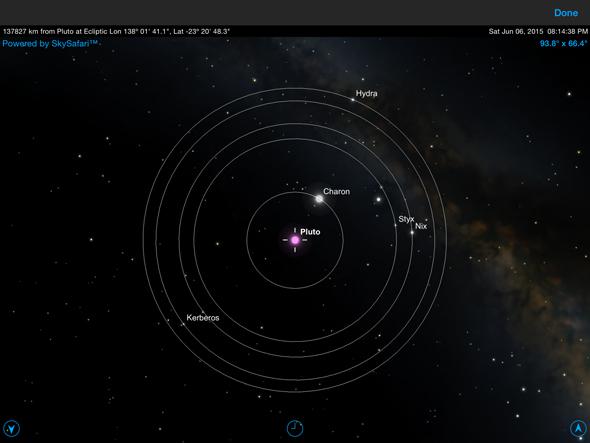In a month, the New Horizons will scream through the Pluto system, providing the first close-up photos (as well as a dizzying array of other data) of the little world and its littler moons.
There are a couple of new ways you can join in on this journey, albeit vicariously.
One comes from the New Horizons team, an idea called “Pluto Time”. Pluto is nearly five billion kilometers from the Sun, and our star is considerably dimmer at that distance, on average about 250 times as bright as the full Moon. High noon on Pluto is like dusk or dawn here on Earth, when the Sun is just on the horizon. That’s when it’s Pluto time!
NASA has a tool to find your local Pluto time: Just go there, enter your location, and it will tell you when the illumination you experience is about the same as that on Pluto. It’s not exact; clouds, mountains on the horizon (a factor here in Colorado east of the Rockies), and other factors complicate this, but that’s not the point. The idea is to get a feel for how much darker it is on Pluto than on Earth. For my location, Pluto time is about 8:30 p.m. local time. What is it for you?
NASA and the New Horizons team encourage you to try this, then take a photo at your location and share it on social media. This is a clever idea, and way to get people experience what it’s like somewhere far, far outside their usual experience. In this case, literally.
If you want to learn more about Pluto and New Horizons, the folks at Simulation Curriculum (who make the wonderful Starry Night and SkySafari software; the latter is my go-to app for looking up sky maps) have put out a free interactive app called Pluto Safari*. It’s pretty interesting, loaded with info about the mission including a timeline, where New Horizons is now, different views of the trip and Pluto system (from the viewpoint of the probe, from Pluto, from Earth; all interactive and fun), and a link to current news.
I played with this for a while, and it’s cool. To be honest the most amazing thing to me is the countdown distance indicator; watching it tick down at a staggering 14 km per second gives you a real sense of just how flippin’ fast that spacecraft is hauling. Of course, there’s a countdown clock as well, and you can watch and let the excitement build as we get closer to his enigmatic world.
Pluto Safari is available for iOS and Android (and a reminder, it’s free).

Photo by NASA/JHUAPL/SwRI
As I write this, New Horizons is still about 45 million km from Pluto, but even from that distance we’re starting to see surface features, even in the raw data. The next few weeks are going to be very exciting.
* Full disclosure: I was contacted by Simulation Curriculum about the app, and after I checked it out and told them I would write about it they offered me an upgrade to Sky Safari and Starry Night. I would’ve written this post either way, and still said that I like their software!
